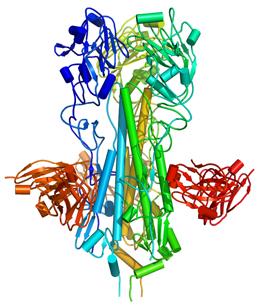 The H5 hemagglutinin (yellow and blue) bound to an antibody (red).W. Hwang
The H5 hemagglutinin (yellow and blue) bound to an antibody (red).W. HwangPosted on 02/22/2009 11:44:33 PM PST by neverdem
Discovery hints at the possibility of broad-spectrum vaccines.
Researchers have identified a group of antibodies that neutralize a wide range of influenza viruses, including the H5N1 avian influenza, the 1918 Spanish flu and some seasonal strains. These molecules may one day be used therapeutically to protect patients against a broad array of strains.
The antibodies also give researchers clues about how to develop new vaccines. "This opens up the avenue of thinking about universal influenza vaccines, which has not been realistic before", says Peter Palese, an influenza expert at Mount Sinai School of Medicine in New York who was not involved in the work.
 The H5 hemagglutinin (yellow and blue) bound to an antibody (red).W. Hwang
The H5 hemagglutinin (yellow and blue) bound to an antibody (red).W. HwangInfluenza is notoriously adept at mutating, meaning that flu vaccines must be reformulated almost every year. And if a highly pathogenic strain were to arise, it would take months to generate antibodies to fight it. Researchers are thus keen to find ways to protect against as many flu strains as possible.
Aiming to find antibodies against H5N1, Wayne Marasco and colleagues at the Dana-Farber Cancer Institute in Boston screened a library of human antibodies against the 'H5' version of hemagglutinin, the viral protein responsible for getting the virus into cells. But they quickly discovered that their antibodies recognized other variants, too. "We were very surprised", says Jianhua Sui, the first author of the study, which was published in Nature Structural & Molecular Biology1.
Ruben Donis and colleagues at the Centers for Disease Control and Prevention in Atlanta then checked whether the antibodies could neutralize viruses in cell culture. For almost all the variants tested, the answer was yes. In addition, mice treated with the antibodies survived when they were later exposed to lethal doses of H5N1 and H1N1 influenza.
Recently, several teams have identified similar broadly neutralizing antibodies2,3, but their mechanism was unknown. So the Marasco group teamed up with Robert Liddington and William Hwang of the Burnham Institute in La Jolla, California, to determine the crystal structure of one of Sui's antibodies bound to a hemagglutinin. They found that the antibody interacted not with the hemagglutinin's head, as antibodies often do, but rather with its stem.
This tactic appears common among the new antibodies. They poke deep into a pocket of the stem, apparently paralyzing hemagglutinin so it cannot change its shape in the way needed for the virus to fuse with the cell membrane. Many influenza strains share the same stem structure, which likely explains why the antibodies can react with them all. Marasco speculates that viruses use mutation-tolerant heads to distract the immune system from the stems.
Based on these results, a vaccine that directed the immune system to the hemagglutinin's stem could provide broad, long-lasting protection. Making such a vaccine would involve engineering a hemagglutinin in which the head is deleted or somehow covered up, but which maintains the stem structure. "That's a challenge", Palese says, but it's "possible to do".
The researchers are also optimistic about the more immediate goal of using the new antibodies themselves for treatment. Antibody-based treatment would not be widely practical, but it could help contain a pandemic. Moreover, seasonal influenza kills 250,000 people worldwide every year, with the most vulnerable being anyone unable to mount an effective immune response. "For those people, this could be life-saving", Marasco says.
The antibodies do fail to recognize some hemagglutinin variants, apparently because of a structural difference in the stems. It appears, however, that there are only two fundamental stem structures among all influenza hemagglutinins. So the strategies employed in this study could also be used to target the remaining variants.
"You might be asking too much if you're looking for one vaccine for every conceivable influenza", says Anthony Fauci, director of the National Institute of Allergy and Infectious Diseases (NIAID) in Bethesda, Maryland. "If you have one or two that cover the vast majority of isolates, I wouldn't be ashamed to call that a universal vaccine."
The NIAID is preparing to test the antibodies in ferrets.
Save this link! 10.1073/pnas.0801367105 is the DOI of the 2nd citation. The 2nd & 3rd citations are FReebies.
micro ping
Check comment# 1.
Ping! (Thanks, neverdem!)
Bump for later reading.
Thanks, SJ.
Ping.
Comment #2 is more interesting...
bttt
Disclaimer: Opinions posted on Free Republic are those of the individual posters and do not necessarily represent the opinion of Free Republic or its management. All materials posted herein are protected by copyright law and the exemption for fair use of copyrighted works.